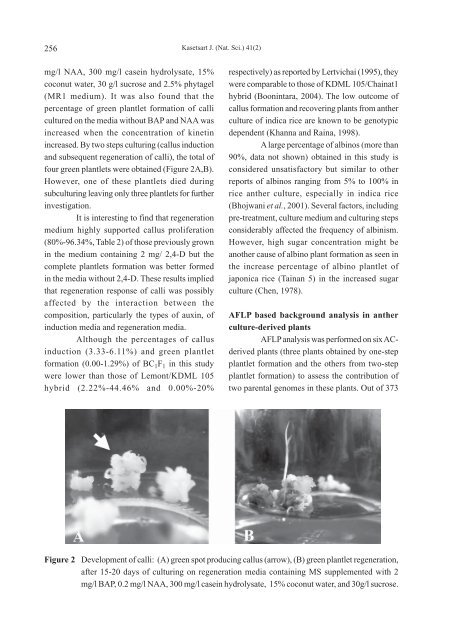April - June 2007 - Kasetsart University
April - June 2007 - Kasetsart University
April - June 2007 - Kasetsart University
Create successful ePaper yourself
Turn your PDF publications into a flip-book with our unique Google optimized e-Paper software.
256<br />
mg/l NAA, 300 mg/l casein hydrolysate, 15%<br />
coconut water, 30 g/l sucrose and 2.5% phytagel<br />
(MR1 medium). It was also found that the<br />
percentage of green plantlet formation of calli<br />
cultured on the media without BAP and NAA was<br />
increased when the concentration of kinetin<br />
increased. By two steps culturing (callus induction<br />
and subsequent regeneration of calli), the total of<br />
four green plantlets were obtained (Figure 2A,B).<br />
However, one of these plantlets died during<br />
subculturing leaving only three plantlets for further<br />
investigation.<br />
It is interesting to find that regeneration<br />
medium highly supported callus proliferation<br />
(80%-96.34%, Table 2) of those previously grown<br />
in the medium containing 2 mg/ 2,4-D but the<br />
complete plantlets formation was better formed<br />
in the media without 2,4-D. These results implied<br />
that regeneration response of calli was possibly<br />
affected by the interaction between the<br />
composition, particularly the types of auxin, of<br />
induction media and regeneration media.<br />
Although the percentages of callus<br />
induction (3.33-6.11%) and green plantlet<br />
formation (0.00-1.29%) of BC 1F 1 in this study<br />
were lower than those of Lemont/KDML 105<br />
hybrid (2.22%-44.46% and 0.00%-20%<br />
<strong>Kasetsart</strong> J. (Nat. Sci.) 41(2)<br />
respectively) as reported by Lertvichai (1995), they<br />
were comparable to those of KDML 105/Chainat1<br />
hybrid (Boonintara, 2004). The low outcome of<br />
callus formation and recovering plants from anther<br />
culture of indica rice are known to be genotypic<br />
dependent (Khanna and Raina, 1998).<br />
A large percentage of albinos (more than<br />
90%, data not shown) obtained in this study is<br />
considered unsatisfactory but similar to other<br />
reports of albinos ranging from 5% to 100% in<br />
rice anther culture, especially in indica rice<br />
(Bhojwani et al., 2001). Several factors, including<br />
pre-treatment, culture medium and culturing steps<br />
considerably affected the frequency of albinism.<br />
However, high sugar concentration might be<br />
another cause of albino plant formation as seen in<br />
the increase percentage of albino plantlet of<br />
japonica rice (Tainan 5) in the increased sugar<br />
culture (Chen, 1978).<br />
AFLP based background analysis in anther<br />
culture-derived plants<br />
AFLP analysis was performed on six ACderived<br />
plants (three plants obtained by one-step<br />
plantlet formation and the others from two-step<br />
plantlet formation) to assess the contribution of<br />
two parental genomes in these plants. Out of 373<br />
Figure 2 Development of calli: (A) green spot producing callus (arrow), (B) green plantlet regeneration,<br />
after 15-20 days of culturing on regeneration media containing MS supplemented with 2<br />
mg/l BAP, 0.2 mg/l NAA, 300 mg/l casein hydrolysate, 15% coconut water, and 30g/l sucrose.
















